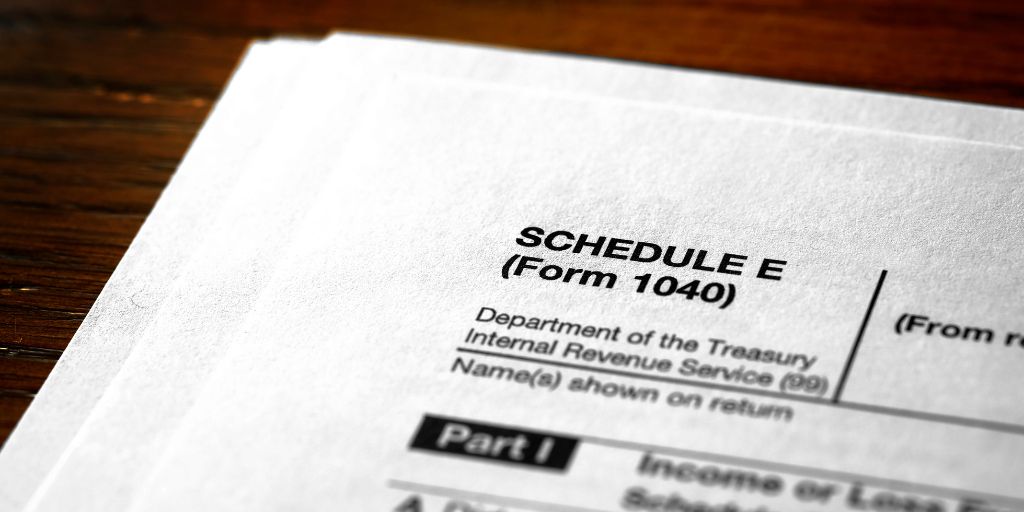What Is Schedule E?
What Is Schedule E For?
Schedule E is for reporting supplemental incomes or losses. “Supplemental income” includes income and/or loss from real estate, trusts, residential interests in real estate mortgage investment conduits (REMICs)[1], royalties, partnerships, and S corporations[2].
Because supplemental income is passive income, the IRS does not subject incomes reported in Schedule E to self-employment tax. This rule applies even if landlords and lessors actively participate[3] in their rental properties.

Self-employment income is classified as earned income or business income. A taxpayer uses Schedule C instead to report incomes and/or losses from business endeavors.
Schedule E vs. Schedule C
Schedule E reports real estate-related incomes, while Schedule C reports business incomes.
The biggest advantage of Schedule E is that the earnings reported on it are immune to self-employment taxes; those on Schedule C are not.
However, the taxpayer’s maximum deductible amount on losses for Schedule E are capped at $25,000. By contrast, the losses reported on Schedule C are uncapped because of the taxpayer’s material participation in the business. They can also list any expense as a deduction to drive down taxable income.
That said, Schedule E and Schedule C usually do not apply to the same kind of taxpayers, so there is no reason someone should have to choose between them.
What Is Not Reported on Schedule E?
All incomes and losses of anybody considered self-employed by the IRS should not be reported on Schedule E.
The IRS defines self-employed individuals as those operating a personal business as a sole proprietorship or a single-member limited liability company. Freelancers and independent contractors also belong to this class of taxpayers.
For example, Uber and Lyft drivers file Schedule C to report their incomes or losses to the IRS[4]. Meanwhile, Airbnb hosts use Schedule E to report incomes and losses from transient rentals.
Less commonly, Airbnb hosts may have to fill out Schedule C under certain conditions[5]. One of them is when they receive earnings by providing guests with additional services like housekeeping[6]. Offering such services suggests that the revenue is made actively, so it is not considered passive income.
What Is Self-Rental on Schedule E?
Self-rental on Schedule E refers to property rented by a business controlled by the property owner or the property owner’s spouse[7]. Hence self-rental, or renting one’s own property.
This rule prevents property owners from manipulating rental incomes and losses to reduce tax liabilities.
Under this rule, any net income from a property tied to a self-rental arrangement gets recharacterized from passive to non-passive. In other words, one cannot use Schedule E to offset net losses from other passive activities.
At the same time, any net losses from a self-rental remain passive. If the property owner did not have any passive income on Schedule E in the tax year, the loss is temporarily suspended and carried forward to future tax years.
For example, a taxpayer owns a commercial building with two tenants. One is a restaurant the taxpayer materially participates[8] in as its owner and the second is an apartment owned by an unrelated third party.
At the end of the tax year, the commercial building generated a net income of $80,000 while the apartment records a loss of $20,000.
In this case, the building’s net income is non-passive, but the apartment’s loss is passive. This means the loss cannot be deducted from the building’s income. If the scenario is reversed (where the building nets a $20,000 loss and the apartment tallied an $80,000 income), then the building’s loss can be deducted from the apartment’s income.
The self-rental rule applies until the previous owner does not have material participation in the property for 5 out of 10 years[9].
How Is Schedule E Income Calculated?
The IRS calculates Schedule E income by adding amounts reported in the form and subtracting rent and royalties that apply from the sum.
A Schedule E allows a taxpayer to report three rental real estate properties. For each one, the taxpayer should indicate the property type, the number of days it was rented, and the number of days it was personally used.
The IRS requires the taxpayer to enter the total amounts reported on lines 3 (rents earned), 4 (royalties earned), 12 (mortgage interest paid to banks, etc.), 18 (depreciation expense or depletion), and 20 (expenses).
Add lines 5 through 19, then subtract the total rents and royalties earned from the sum of all expenses.
Afterward, the taxpayer should enter all expenses. The following are the categories of expenses on Schedule E:
- Advertising.
- Auto and travel.
- Cleaning and maintenance.
- Commissions.
- Insurance.
- Legal and other professional fees.
- Management fees.
- Mortgage interest paid to banks, etc.
- Other interest.
- Repairs.
- Supplies.
- Taxes.
- Utilities.
- Depreciation expense or depletion.
- Others.
Other Considerations When Computing Schedule E Income
Some special circumstances may arise when computing Schedule E income. Here are some of them.
- If the result is a loss, the taxpayer may have to file Form 6198.
- If there is any deductible rental real estate loss after limitation on Form 8582, one must include it on Schedule E too.
- If a property meets the criteria for a qualified joint venture[10], the taxpayer should check the QJV box.
- If the figure on line 21 is a negative, line 24 has to be left blank. Otherwise, enter the amount.
- Line 25 is reserved for total losses, so add all rental real estate property and royalty losses.
- On line 26, combine lines 24 and 25 to determine the total real estate and royalty income or loss.
- On line 3, the taxpayer should declare the rents earned per property. If applicable, the same applies to all royalties earned.
Takeaways
- Schedule E is an IRS tax form that reports supplemental incomes and losses, such as real estate-related income and loss. It is usually filed alongside Form 1040, or the annual income tax return.
- Schedule E applies to passive activities involving real estate rental properties, estates, trusts, residential interests in REMICs, royalties, partnerships, and S corporations.
- Self-employed individuals, including Airbnb hosts, do not need to file Schedule E when reporting their incomes. They should file Schedule C instead.
Sources
- Brady, M. (2022.) What is a Real Estate Mortgage Investment Conduit? wiseGEEK. Retrieved from https://www.wisegeek.net/what-is-a-real-estate-mortgage-investment-conduit.htm
- Internal Revenue Service. (2017.) S Corporations. Retrieved from https://www.irs.gov/businesses/small-businesses-self-employed/s-corporations
- TaxAct. (n.d.) Active and Passive Material Participation Passive Activity. Retrieved from https://www.taxact.com/support/1639/2016/active-and-passive-material-participation-passive-activity
- Medine, T. (2022.) The Ultimate Guide To Filing Self-Employment Taxes. The Journal Times. Retrieved from https://journaltimes.com/business/investment/personal-finance/the-ultimate-guide-to-filing-self-employment-taxes/article_9d204d73-4b9d-51d8-be56-acb55956944a.html
- Hofmann, M. (2019.) Tax Treatment of Home-Sharing Activities. The CPA Journal. Retrieved from https://www.cpajournal.com/2019/11/11/tax-treatment-of-home-sharing-activities/
- Stephen Fishman, S. (2021.) Tax Issues When Renting Your Home on Airbnb or VRBO. Nolo. Retrieved from https://www.nolo.com/legal-encyclopedia/tax-issues-when-renting-your-home-airbnb-vrbo.html
- Rowe, D. (n.d.) Self-Rental Rule. CCIM Institute. Retrieved from https://www.ccim.com/cire-magazine/articles/139452/2012/01/self-rental-rule/
- Murray, J. (2020.) How Material Participation Works in a Business Loss. The Balance Small Business. Retrieved from https://www.thebalancesmb.com/what-does-material-participation-in-a-business-mean-398343
- Constantine, A. (2008.) Avoiding the Self-Rental Trap. The Tax Adviser. Retrieved from https://www.thetaxadviser.com/issues/2008/aug/avoidingtheself-rentaltrap.html
- Sell, K. (2018.) Qualified joint ventures for spouses. Journal of Accountancy. Retrieved from https://www.journalofaccountancy.com/issues/2018/oct/irs-qualified-joint-ventures-for-spouses.html








